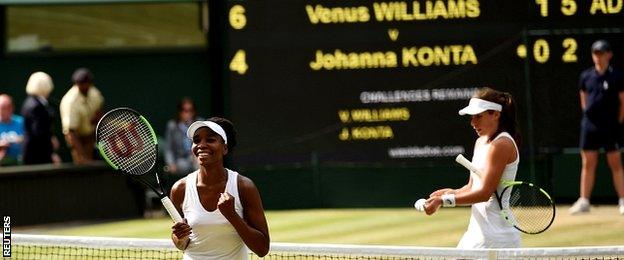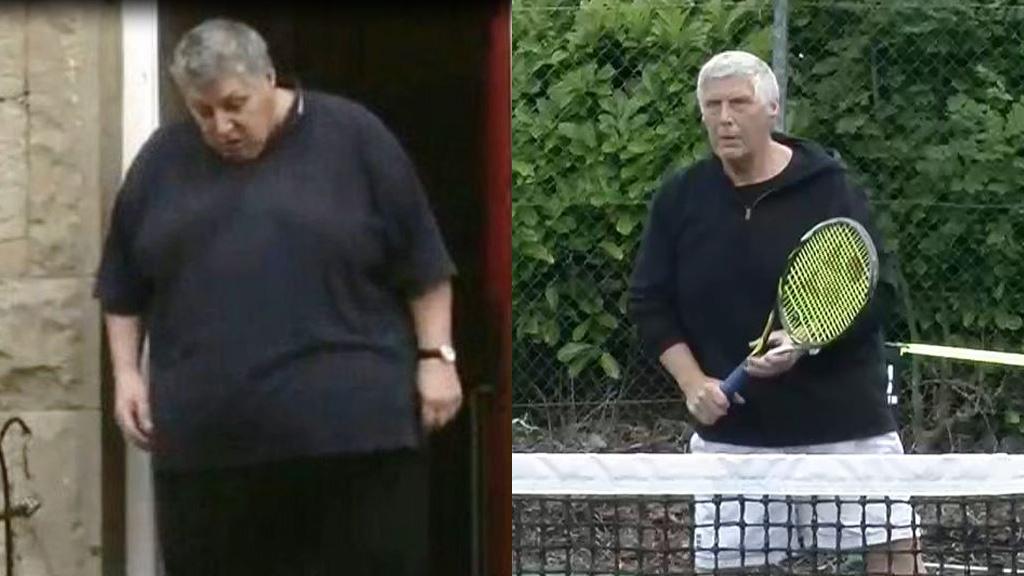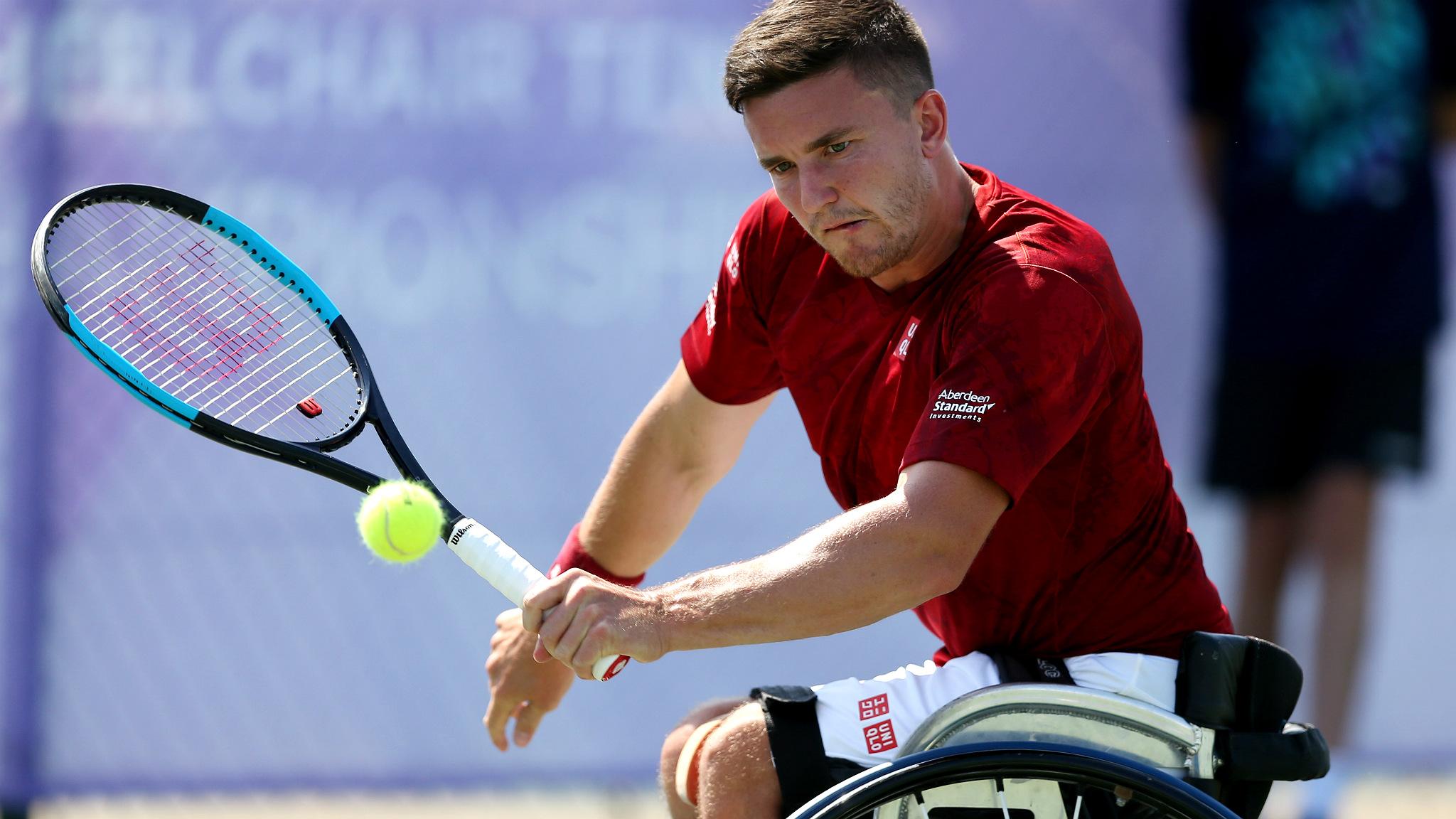Johanna Konta up to fourth in rankings, Andy Murray remains number one
- Published
- comments

Andy Murray first felt his hip problem after reaching the French Open semi-finals in June
Britain's Johanna Konta has risen to a career-high fourth in the women's rankings after Wimbledon, while Andy Murray remains men's world number one.
Konta, 26, is the fourth British woman to break into the top five, following her run to the Wimbledon semi-finals.
She matches the achievement of Virginia Wade, Sue Barker and Jo Durie, the last British woman in the top five in 1984.
Murray, 30, lost in the Wimbledon quarter-finals but retains top spot ahead of Rafael Nadal.
The Spaniard could overtake Murray at the pair's next tournament, the men's Rogers Cup in Montreal, which begins on 7 August.
However, the Scot's Wimbledon campaign was hampered by a hip injury and he has yet to confirm whether the recovery process will alter his plans for the rest of 2017.
Major goals in sight for Konta
Johanna Konta happy with Wimbledon performance despite semi-final defeat
Konta further established her credentials as a Grand Slam title contender by reaching her second major semi-final at Wimbledon, and she now heads to the United States and her best surface - hard courts.
The British number one is next due on court at the women's Rogers Cup, which starts in Toronto on 7 August, having chosen not to defend her title at the Bank of the West Classic in Stanford, California.
Konta beat Venus Williams to win her first WTA title in Stanford last year, and could suffer a dip in her ranking as a result.
The world rankings work on a 52-week rolling system, which means success in one year can mean pressure 12 months later as those points are defended.
Konta enjoyed a strong second half to 2016, narrowly missing out on a place at the WTA Finals for the top eight players, and that will be a major goal in the months to come.
Another tilt at a Grand Slam title will begin on 28 August at the US Open, where Konta has reached the fourth round for the past two years.
'Jo has learned so much, and will apply it'

Konta could not break Williams' serve in their semi-final
Konta will pick up her racquet and get back on the practice court having finished Wimbledon at the top of the aces charts and fourth for first-serve returns.
But, while the foundations of her game are strong, Williams exposed some areas for improvement in their semi-final.
"Jo's got a great game," said former British number one Sam Smith.
"She's an excellent athlete and mentally she's a top, top player. If I know anything about Jo, she is going to learn so much from that match against Venus, and apply it."
Konta failed to break into the top 100 in the early years of her career, with a fragile mentality and unreliable forehand two of the major factors.
Her work with both mental and tennis coaches in recent years has proved remarkably effective, and she held up under huge pressure as her Wimbledon run garnered nationwide attention.

Konta's forehand was strong as he reached the semi-finals, but Williams found a way to counter it
Konta's forehand stood up well during tense three-set wins over Donna Vekic, Caroline Garcia and Simona Halep, before Williams broke it down and drew 16 errors in the semi-final.
It was notable both Williams and Garbine Muguruza also struggled with their forehands at key moments in the final, but the Spaniard managed to cut the errors from six in the first set to one in the second.
Williams also dismantled the Konta second serve, making her intentions clear from the opening moments when she stood inside the baseline and dispatched a second-serve return, while the Briton missed service returns at key times in both her semi and quarter-finals.
"Jo didn't use the body serve enough and she can improve her second serve," said Martina Navratilova, a nine-time Wimbledon singles champion.
"She can use her hand more and make that ball jump. She's tall enough and got a nice motion that I think she doesn't take full advantage of.
"But that forehand has got to be more steady, although she's improved it, and the transition game, moving to the net.
"Also the backhand slice, she doesn't use it at all. Her backhand is fantastic but the slice would give it more variety and put the opponent off balance."
'I'd say the US Open would be 50/50'
Murray may rest before US Open
Murray's future is far less certain as we await an update on his injured hip and the rehabilitation plan.
The Briton limped his way through four rounds at Wimbledon before it became "a little bit too sore", and Sam Querrey proved too strong, in their quarter-final.
"Murray and his team have obviously been trying to manage something," said former world number one John McEnroe.
"We don't know exactly what it is, how serious it is, and how much time he'll take off remains to be seen.
"He clearly wasn't moving well, he couldn't push off and lost a lot of speed on his serve."
A team meeting was planned for last Thursday, and a plan of action is expected after consultation with doctors.
Asked whether he would have attempted to play had it been anywhere but Wimbledon, Murray said: "I was in good enough shape to go very deep in the tournament and almost managed to get through to the semi-finals.
"Any Slam, I would have taken that with how I was feeling before the tournament started. I would have been out there for a Slam."

Andy Murray will assess his fitness before deciding his schedule for the rest of 2017
Murray refused to be drawn on the specific nature of the injury beyond confirming he has dealt with it since his early 20s, and "wear and tear" made it an ongoing issue.
The recovery plan could mean anything from a few weeks' rest and physiotherapy, to a much longer lay-off or even surgery.
"I'd say the US Open would be 50/50 at a guess," Giles Stafford, a consultant orthopaedic surgeon specialising in sports-related hip disorders, told the Press Association.
Murray, then aged 26, ended his 2013 season in September to have back surgery and returned at the start of 2014, but spent the year climbing back up the rankings as he rebuilt his form and confidence.
He is next scheduled to play in Montreal in three weeks' time, followed by the Cincinnati Masters the following week and, after a week off, the US Open.
Murray could lose his number one status to Nadal should he skip Montreal but, after eight months in top spot, the ranking is not his priority.
"I haven't played well enough this year to deserve to stay there for much longer," he said.
"If it doesn't happen by the end of Wimbledon, it will happen by the end of the US Open."
If and when he does return this year, Murray will head into the latter stages of the season with a 25-10 record, as opposed to 41-6 after Wimbledon last year.
- Published15 July 2017

- Published13 July 2017
- Published14 July 2017

- Published18 July 2017

- Published2 July 2018

- Published17 June 2019
